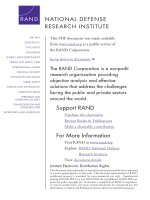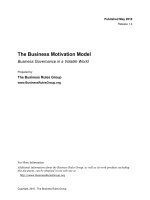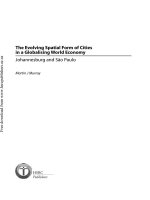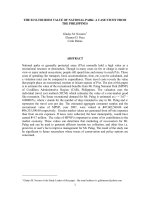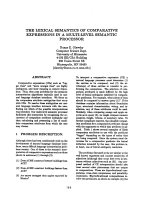The Evolving Spatial Form of Cities in a Globalising World Economy pot
Bạn đang xem bản rút gọn của tài liệu. Xem và tải ngay bản đầy đủ của tài liệu tại đây (591.08 KB, 64 trang )
TheEvolvingSpatialFormofCities
inaGlobalisingWorldEconomy
JohannesburgandSãoPaulo
MartinJMurray
HSRC
Publishers
Free download from www.hsrcpublishers.ac.za
III
DemocracyandGovernanceResearchProgramme,OccasionalPaper5
SeriesEditor:AdamHabib,ExecutiveDirector:DemocracyandGovernanceResearchProgramme,HumanSciences
ResearchCouncil
PublishedbyHSRCPublishers
PrivateBagX9182,CapeTown,8000,SouthAfrica
www.hsrcpublishers.ac.za
©2004HumanSciencesResearchCouncil
Firstpublished2004
Allrightsreserved.Nopartofthisbookmaybereprintedorreproducedorutilisedinanyformorbyanyelectronic,
mechanical,orothermeans,includingphotocopyingandrecording,orinanyinformationstorageorretrievalsystem,
withoutpermissioninwritingfromthepublishers.
ISSN1726-0175
ISBN0796920729
CoverbyJennyYoung
ProductionbycomPress
DistributedinAfricabyBlueWeaverMarketingandDistribution,
POBox30370,Tokai,CapeTown,7966,SouthAfrica.
Tel:+27+21-701-4477
Fax:+27+21-701-7302
email:
Distributedworldwide,exceptAfrica,byIndependentPublishersGroup,
814NorthFranklinStreet,Chicago,IL60610,USA.
www.ipgbook.com
Toorder,calltoll-free:1-800-888-4741
Allotherinquiries,Tel:+1+312-337-0747
Fax:+1+312-337-5985
email:
Free download from www.hsrcpublishers.ac.za
III
Preface
The Democracy and Governance Research Programme of the Human Sciences
Research Council publishes an Occasional Paper series which is designed to offer
timelycontributionstodebates,disseminateresearchfindingsandotherwiseengage
withthebroaderresearchcommunity.Authorsinvitecommentsandresponsesfrom
readers.
Free download from www.hsrcpublishers.ac.za
AbouttheAuthor
MartinJMurrayisProfessorofSociologyattheStateUniversityofNewYorkin
Binghamton. He is the author of numerous books, including The development of
capitalismincolonialIndochina(BerkeleyandLosAngeles:UniversityofCalifornia
Press 1980), South Africa: time of agony, time of destiny (London and New York:
Verso1987),andRevolutiondeferred:thepainfulbirthofpost-apartheidSouthAfrica
(LondonandNewYork:Verso1995).Heiscurrentlyinterestedinquestionsofurban
space, including modernist (and post-modernist) city building, the contradictory
impulsesofrealestatecapitalism,theexclusionaryeffectsofbunkerarchitecture,and
placemakingasboundarymarking.
IV
Free download from www.hsrcpublishers.ac.za
TheEvolvingSpatialFormofCities
inaGlobalisingWorldEconomy
JohannesburgandSãoPaulo
Introduction
The ‘global cities’ paradigm has drawn our attention to the pivotal role of large
metropolisesaskeycommandandcontrolcentreswithinthecapitalistworldeconomy.
Acentralaxiomofthisinnovativetheoreticalframeworkistheclaimthatthespatial
dispersalofgiant‘multi-national’corporationsoverconsiderabledistancesrequiresa
parallelterritorialconcentrationof‘commandandcontrol’functionsattheapexof
theglobalurbanhierarchy.Yetbyprivilegingthefunctionalspecialisationsoflarge
metropolitanregionswithintheworldeconomy,the‘globalcities’approachrestricts
thekindsofquestionsthatcanbelegitimatelyaddressedwithinitsconceptualframe
ofreference.Inparticular,bynarrowingthescopeofresearchtothefunctionalroles
ofcitieswithintheworldeconomy,the‘globalcities’paradigmtendstodownplay
theevolvingspatialformof citiesthataspireto‘world-class’ status.Incontrast,a
growing number of scholars have focused instead on the changing morphological
characteristicsofurbanlandscapes,and,inparticular,ontheuse,management,and
regulationofurbanspace.Byemphasisingsuchspatialfeaturesasunfetteredurban
sprawl,theurbanisationoftheperiphery,theproliferationof‘edgecities’,andthe
emergenceofanew‘fortificationaesthetic’thathasaccompaniedtheconstruction
ofsuchpost-publicplacesasfestivalmarketplaces,citadelofficecomplexes,enclosed
shoppingmalls,andgatedresidentialcommunities,thesetheoristsofurbanlifehave
drawnattentiontotheevolvingpatternsofspatialrestructuringassociationwitha
1
Free download from www.hsrcpublishers.ac.za
MartinJMurray
2
TheEvolvingSpatialFormofCitiesinaGlobalisingWorldEconomy
3
distinctivekindofpolynucleatedandfragmentedcity-form,onewhichsomescholars
havecalled‘postmodernurbanism’.
Attheriskofoversimplification,itispossibletoidentityfivefeaturesassociated
with‘post-modernurbanism’.Whilethesedonotexhaustthepossiblecharacteristics
of this particular kind of urbanity, they do constitute its central elements.
Concentrating on the extent to which these characteristic features of postmodern
urbanismcanbefoundintwoaspirant‘world-class’cities–JohannesburgandSão
Paulo–enablesustohighlighttheglobaldispersalofanewkindofurbanformthat
hasdevelopedaroundtheworld.Oneofthedeficienciesinexistingurbanscholarship
isthegreatgapbetweenthegrand,totalisingtheorieslikethe‘globalcities’paradigm
orthe‘post-modernurbanism’ideasassociatedwiththeso-calledLosAngeles(LA)
Schoolandempiricalstudiesofcitiesthatare,sotospeak,‘offthemap’.Looking
at these ‘ordinary cities’ that fall outside the glare of the core zones of the world
economyprovidesuswithanunusualopportunitytoinvestigateinsomedetailhow
theglobalisingtendenciesof city-buildingtrickledowntoaspiring to‘world-class’
statusbutthosewhicharelocatedwellbelowthetopofthe‘globalcities’hierarchy.
ThepioneeringworkofurbantheoristssuchasJohnFriedmannandGoetzWolff,
Saskia Sassen, Manuel Castells, Peter Taylor, Anthony King, and Neil Bremner,
amongmanyothers,hasdrawnattentiontothepivotalroleofthecurrentwaveof
globalisation in fostering intensified competition amongst and between cities that
aspireto‘world-class’status.
1
Inthemain,muchofthisscholarlywritingabouturban
rivalrieshascrystallisedaroundaresearchagendathathascometobeknownasthe
‘global cities’ paradigm. Scholars operating within this framework have sought to
reassesstheimportanceoflarge metropolisesaskeycommandand controlcentres
withintheinterlockingglobalisingdynamicsoffinancialmarkets,high-levelproducer
services industries, corporate headquarters and other associated business-services
industries (telecommunications, business conferences, media, design and cultural
industries,transport,andpropertydevelopments).Acentraltenetofthisinnovative
theoretical framework is the contention that the spatial dispersal of transnational
corporations(TNCs)overincreasinglyglobaldistancesrequiresaparallelterritorial
concentration of ‘command’ functions at the apex of the global urban hierarchy
(Amin&Graham1997).
Inshort,theglobalintegrationofhigh-levelheadquarterfunctionshas created‘a
newstrategicroleformajorcities’.Beyondtheirconventionalhistoricalroleascentral
sitesformanagingworldwidetradeandinternationalbankingandfinance,emergent
‘globalcities’nowfunctionas‘highlyconcentratedcommand[andcontrol]pointsin
theorganisationoftheworldeconomy’andaskeylocationsfortransnationalcorporate
Free download from www.hsrcpublishers.ac.za
MartinJMurray
2
TheEvolvingSpatialFormofCitiesinaGlobalisingWorldEconomy
3
head offices.
2
While globalisation has affected all kinds of geographical localities
in a variety of ways, it assumes particular significance in those key urban centres
thatscholars havelabelled‘global’ or‘worldcities’.Inshort,globalisationprecedes
and largely determines urban spatial and sociocultural restructuring, inexorably
transformingemergentglobalcitiesbydisconnectingthemfromtheirlocalties.
3
In its original formulation, the ‘global cities’ thesis laid particular stress on the
historically specific functions of London, New York and Tokyo at the apex of
the world-scale urban hierarchy. At the outset, discussion focused on clarifying
terminological disputes (‘world’ versus ‘global’ cities), refining initial definitions,
and postulating about which cities might be included under the rubric of ‘global
cities’andwhatcriteriamightbeusedtodeterminetheirrankorder.Overtime,the
‘globalcities’debatehasmovedawayfromitsrelativelynarrowfocusonafewleading
urbancentrestoamuchmorenuanced,sophisticatedandbroadertheorisationofthe
changingfunctionsofcitiesinaglobalisingworldeconomyincreasinglydominated
byinformationalisedeconomicactivities(Castells1996;Lo&Yeung1998;Marcuse
&VanKempen2000a;Sassen2000a,2000c).Takenasawhole,the‘globalcities’
model –withits particular stressontheevolving networkof interconnectedurban
centres–hassparkedagreatdealofsubstantiveresearchthathasgreatlyadvancedour
understandingoftheplaceandfunctionofcertainstrategicallylocatedcitiesinthe
spatialgeographyofthecontemporaryworldeconomy.Bysituatinglargemetropolitan
regions within a common ‘globalising’ framework, this approach has opened up
uniquepossibilitiesforfruitfulcomparisonsthatpromisetoyieldnewinsightsintothe
changingrolesofcitiesinthecontemporaryworldeconomy(Abu-Lughod1999;Abu-
Lughod2001;Nijman1997;Portes&Stepick1993;Sassen&Portes1993).
Nevertheless, despite its considerable strengths as an orienting framework
forempirically groundedresearch,the ‘global cities’approach is not without its
theoretical limitations as an overarching paradigm for studying contemporary
cities.
4
Byidentifyingcertainkeyurbancentresasmaterialmanifestationsofthe
structuralprocessesofglobalisation,the‘globalcities’approachhasincorporateda
certainfunctionalistandeconomisticbiasintoitstheoreticalreasoning.
5
Thisway
ofthinkinghasinadvertentlycontributedtoanarrowingofthefieldofvisionfor
urbanstudies.Byanalyticallyprivilegingthefunctionalrolesandspecialisationsof
largemetropolitancentresintheglobalmarketplace,andbycategorisingcitiesinto
arankedhierarchyroughlyinaccordancewiththeeconomicpowertheycommand,
the‘globalcities’approachlimits,inanaprioriway,thekindsofquestionsthat
can be legitimately addressed within its theoretical framework (Robinson 2002;
Smith1998).
Free download from www.hsrcpublishers.ac.za
By directing attention primarily to transnational business and financial networks
thatlinkleadingmetropolitancentresinaglobalhierarchydefinedprimarilybymarket
relations,the‘globalcities’literaturetendstodownplayoroverlooktheevolvingspatial
dynamicsoflargecities thataspire to ‘world-class’ status. In contrast,urbantheorists
suchasDavidHarvey,JohnHannigan,NanEllin,MichaelDear,StevenFlusty,Diane
Ghirado,MichaelSorkin, MikeDavis, Christine Boyer,SharonZukin,EdwardSoja,
ChristopherJencksandmanyothershavefocusedinsteadonthechangingmorphological
characteristics of urban landscapes and, in particular, on the use, management and
regulationofcityspace(Boyer1998;Davis1985;Dear2000;Dear&Flusty1998;Ellin
1996;Ghirado1991;Harvey1989;Hannigan1998;Jencks1993;Soja1989;Soja1992;
Sorkin1992;Zukin1998).Inlookingatthefragmentationoftheurbanrealmintowhat
DavidHarveycalls‘apatchworkquiltofislandsofrelativeaffluencestrugglingtosecure
themselvesinaseaofspreadingdecay’(Harvey2000:152),thesescholarshavedrawnour
attentiontothespatialityofcontemporarycities.Byhighlightingsuchspatialfeaturesas
‘edgecities’,gatedresidentialcommunitiesandotherprivatopias,fortifiedofficecitadels,
downtown renaissance zones,festival marketplaces and other enclosed shopping mall
extravaganzasastheyappearincitiesaroundtheworld,theseurbantheoristshavedrawn
ourattentiontotheevolvingpatternsofspatialrestructuringassociatedwithadistinctive
kindofpolynucleatedandfragmentedcityform,onewhichsomescholarshavecalled
‘postmodernurbanism’.
6
Unlikethe ‘globalcities’paradigmthat takes urban political
economyasitspointofdeparture,thetheoristsof‘postmodernurbanism’lookupon
thecityscapeasacontestedterrain,wherespatialpoliticsinvolvestrugglesovertheuse
ofurbanspace,particularlyinregardtowhobelongswhereandwithwhatentitlements
orcitizenshiprights(Borden,Kerr,Rendell&Pivaro2001;Dovey1999;Harvey2000;
Holston1999;Leach2002;Sandercock1998;Westwood&Williams1997).
As a distinct urban form, postmodern urbanism expresses the confluence of a
multiplicity of macrosocial trends, including deindustrialisation of the metropolis
(wherepost-Fordist‘flexiblespecialisation’hasreplacedFordistmassproductionas
the mainengineofeconomicgrowth),thewidespreadmiddle-classabandonment
ofurbanresidence coupledwithrapidsuburbansprawl,thedevaluationofpublic
space(parks,plazas,streetscapes,sidewalks,collectivemodesoftransportandeasily
accessible places of entertainment), and an awestruck love affair with an ‘inward-
looking’ architectural style that ‘turns its back on’ the surrounding cityscape.
Drivenbytherelentlesspressuresofglobalcompetitioninallitsguises,postmodern
urbanism conforms to an inner logic of spatial partitioning that privileges and
rewardscityscapesthatinsinuatethemselveswithintransnationalcircuitsoffinance
capital.Inaspiringtoachieve‘world-class’status,‘cityboosters’fosterthekindsof
4
MartinJMurray
Free download from www.hsrcpublishers.ac.za
5
business-friendly, urban regeneration strategies that curry favour with large-scale
global corporations by creating cocooned sites of luxury entertainment, shopping
and leisure, while simultaneously leaving poor and working-class urban residents
tofendforthemselvesincompetingforaccesstoaffordablehousing,todwindling
publicspaceandtoprivatised(‘pay-as-you-go’)municipalservices(Connell1999;
Fitzsimons1995;Kenny1995;Loukaitou-Sideris&Banerjee1998).
Postmodern urbanism represents a distinct phase of urban growth and
development, one characterised by the shift from what Christine Boyer calls the
(modernist-inspired) ‘city as panorama’ to the ‘city as spectacle’ (Boyer 1998). It
reflects the collapse of confidence in the holistic design of the urban landscape,
a declining faith in comprehensive urban planning as a panacea for social ills, a
nostalgicfascinationwith‘smallisbeautiful’,aturn todecorativepastiche(orthe
freeplayofstylesandhistoricistallusions)andagrowingmoralpanicassociatedwith
the fear of crime (Huxtable 1997; Jameson 1991; Judd & Fainstein 1999). New
kindsofsegregation–whethersocialorspatial,semioticorsymbolic–havebecome
the visible signs of postmodern urbanism. The main instrument through which
social and spatial segregation is organised is what Teresa Caldeira calls ‘fortified
enclaves’,andtheprincipalrhetoricthatlegitimatesthemisthefearofcrime.The
newpatternsofurbansegregationhavecreatednovelkindsof‘socialspace’–neither
fullypublicnorcompletelyprivate–incontemporarycitiesaroundtheworld,and
these congregating spaces no longer relate to the modern ideals of commonality
anduniversality.Instead,thisnewkindofsocialspaceoperatesontheprincipleof
separatenessandassumesthatsocialgroupsshouldlive,workandspendtheirleisure
timeinhomogenousenclaves,physicallyisolatedfromthosepersonsperceived(and
stigmatised)asdifferent,threateningandunwanted(Caldeira1996b;Caldeira2000;
Davis1992;Merrifield&Swyngedouw1997).
Spacematters:post-modernurbanismand
the‘LosAngelesschool’
TheurbantheoristJanNijmanhasproposedthenotionof‘paradigmaticcity’asa
heuristicdevicethatcanassistusindiviningfuturetrendsinurbanrestructuring.
The ‘paradigmaticcity’maybedefinedastheexemplarymetropolisthatdisplays
moreclearlythanotherurbansitesthedistinguishingfeaturesandgeneraltrendsthat
aresymptomaticofbroadersociogeographicaltransformationsofcitiestakingplace
onaworldscale.Inshort,itanticipates,inagenuinelyprescientway,evolvingand
TheEvolvingSpatialFormofCitiesinaGlobalisingWorldEconomy
Free download from www.hsrcpublishers.ac.za
MartinJMurray
6
TheEvolvingSpatialFormofCitiesinaGlobalisingWorldEconomy
7
unfoldingpatternsofglobalurbanisation.Understoodinthisway,the‘paradigmatic
city’servesasanideal-typicalmodel,alivinglaboratoryforanalysisandaprototype
forinvestigatingtrendsthatarenotasyeteasilydiscernible inothercities. Inthe
1920sand1930s,theso-called‘ChicagoSchool’ofurbanstudies(undertheguiding
hand of Robert Park, Ernest Burgess and Louis Wirth, in particular) defined an
agendaforscholarlyresearchonmetropolitanareasthatachievedundeniablesuccess
asaworkableparadigm.Takingahumanecologyapproachastheiranalyticpointof
departure,the‘ChicagoSchool’urbanistsusedthemodelofconcentricringstodirect
attentiontosuchproblemareasaslandusepatterns,urbanlifestyles,ethnicrivalries
andtheeffectsofurbanenvironmentonhumanbehaviour.Despitechallengesfrom
alternativeperspectives,theChicagoSchooldominatedthefieldofurbanstudiesfor
mostofthetwentiethcentury(Dear&Flusty1997;Nijman2000).
Beginning in the 1980s, a group of urban scholars began to challenge the
conventionalwisdomthattheevolvingurbanlandscapeofthegreaterLosAngeles
metropolitan region was a notable exception to the rules governing process of
urbanisationinthecontemporaryUnitedStates.Theyarguedinsteadthatthisvast,
sprawling urban polyglot was not only symptomatic of wider sociogeographical
transformations of metropolitan regions throughout the United States, but also
a ‘prototype of our urban future’.
7
Despite their loose affiliations and somewhat
differing orientations, these urban theorists became known as the ‘Los Angeles
School’ (LA School), primarily because the vast urbanising sprawl of southern
Californiawasnotonlythesiteofmuchoftheirresearchbutalsothesourceoftheir
inspiration. The scholarly literature clustered around the LA School is filled with
allusions to, and suggestions about, the paradigmatic qualities of the Los Angeles
megalopolis.
8
The focal point of the LA School is the two-sided claim that the
greater Los Angeles metropolitan region not only is emblematic of more general
urbandynamicsthatarecurrentlyreshapingprominentcitiesaroundtheworld,but
also represents the quintessential exemplar of a ‘“mature” postmodern landscape’
(Dear 2000; Dear 2001; Scott 2000; Scott & Soja 1996; Soja 1989; Soja 1996;
Soja 1999; Soja2000).Bymakingastrong‘caseformovingLosAngelesfroma
conceptuallocationasmarginalaberrationtooneofexplanatorycentrality’(Crang
2001:666),leadingLASchoolfiguressuchasMichaelDear,StevenFlusty,Edward
Soja,AllenScott,MichaelStorperandothershaveself-consciouslysoughttodefine
analternativetheoreticalorientationforurbanstudies,arguingthatthenewkindsof
urbanitythathaveevolvedoutofthegreaterLosAngelesmetropolitanregionhave
renderedtheresearchagendaoftheChicagoSchoolobsoleteandoutdated(Cenzatti
1993;Coquery-Vidrovitch2000;Dear&Flusty1997;Dear&Flusty1998;Dear
Free download from www.hsrcpublishers.ac.za
MartinJMurray
6
TheEvolvingSpatialFormofCitiesinaGlobalisingWorldEconomy
7
2000;Dymski&Veitch1996;Flusty1994;Flusty1997;Jencks1996;Keil1990;
Keil1994;Keil1998;Krim1992;Scott&Soja1996;Soja1996;Soja1999;Soja
2000;Storper1999).
Thedangersoffacilegeneralisations
Justlikethe‘globalcities’approach(withitsfocusonglobalurbanhierarchies),the
LASchool–withitsstressonfragmentationandperipheralurbanisation,cultural
hybridisationanddecentredsuburbansprawl–hassignificantlyreshapedthefield
ofurbanstudies.Nevertheless,whetherornottheLASchooloffersanewkindof
pathbreakinganalysisforstudyingurbandevelopmentsaroundtheworldhasbeen
thesubjectofintensedebate.
9
Tobesure,uncriticallyapplyingtheinsightsderived
fromtheLASchoolandpostmodernurbanismtoallcitiesaroundtheworldmaybe
notonlyoverextendingwhatthisconceptualframeworkcanreasonablybeexpected
toaccountfor,butalsounnecessarilyconflatingdivergentprocessesof‘citybuilding’
linkedtohistoricallyspecificsocialandmaterialcircumstances,andflatteningoutthe
richdiversityofwhatconstitutestheurbanexperience.Indeed,theterm‘postmodern
urbanism’ has been invoked in analyses of cities that are as radically different as
KualaLumpur,LasVegas,LosAngeles,PhoenixandBuenosAires.Toavoidsuch
homogenisingtendenciesthatcollapseavarietyofheterogeneousexperiencesarising
fromverydifferenthistoricalprocesses,itisnecessarytobeginwithunderstanding
thattherevanchistfeaturesof postmodern urbanismareneversimplyimposed,as
part-and-parcelofthecurrentphase ofglobalisation,onunsuspectingcities ‘from
above’ and ‘from outside’ without the active participation of local agents on the
ground.Whatpostmodernurbanismreallymeans(i.e.thehistoricallyspecificform
thatittakesinparticularcities)mustbeteasedoutonthebasisoftheanalysisof
specific historical and social circumstances, for ‘city building’ is everywhere the
product of the historically specific intersection of global processes, trends and
relationsthatcometogetherinlocalsettings.
10
Inresponsetotheaggrandising,universalisingclaimsthattheurbanformofLos
Angeles is the paradigmatic exemplar of current urban developments around the
world, numerous urban theorists have cautioned against ‘the dangers of common
generalisations’ or, more precisely, the alluring temptation to adopt uncritically
themodelof‘postmodernurbanism’asthetemplatewithwhichtoassesscritically
evolvingspatialformsofcontemporarycitiesaroundtheworld.Thesescholarsargue
persuasively thatthecausesandspatialconsequencesofgrowingurbaninequality
Free download from www.hsrcpublishers.ac.za
MartinJMurray
8
TheEvolvingSpatialFormofCitiesinaGlobalisingWorldEconomy
9
‘rundeeperthantheoverarchingprocessofglobalisation’.Alternatively,theysuggest
thatpoliticalmeditations,localcontingenciesandpathdependenciescarrysignificant
weightinbringingaboutthevariationinthespatialcontoursofparticularcities.
11
While theorists of postmodern urbanism typically portray cities as fragmented,
partitionedandprecarious,BeauregardandHailastressthepersistenceofcontinuities
in urban landscapes. In their view, ‘the past is transformed; it is not obliterated’.
Thespatialformofthecityhaschanged,‘butnotenoughtosupportclaimsforan
undilutedpostmodernorevenpost-Fordistspatiality’ (Beauregard &Haila2000:
22–23).Similarly,JanetAbu-Lughodarguesconvincinglythat‘generalisationsthat
havebeenadvancedas “newtheories”aboutglobalcities,whilepersuasiveonthe
surface,areofonlylimitedvalueinexplainingvariationsbetweenandwithinspecific
urbanplaces’.Inwarningagainstwhatshecalls‘facilegeneralisations’,shecontends
thatglobalforces‘alwaysinteractwithpreexistingconditionsonthegroundtoyield
consequencesthatarequiteplaceandclassspecific’(Abu-Lughod1999:400,412,
417).
Expressedsuccinctly,asignificantnumberofurbantheoristshavereactedagainst
thetendencyinboththe‘global cities’ andLASchooltoleta city (whetheritis
London,NewYork,Tokyoor Los Angeles)becomeatheory(Crang2001: 665–
669).Thereisaninherentdangerofassuminguni-directional,genericpatternsof
urbantransformationfromsuch‘paradigmatic’cities.Onemustbesensitivetothe
warningthat‘evocationcannotalwaysbeasubstituteforsystematicanalysis’(Amin
& Thrift2002;Thrift1999).Putinanotherway,whatisneededarenotready-
made, deductive urban theories that employ ‘covering laws’ to generalise across
cases,butakindofgenuinetheoreticalopennessandflexibilitythatseeksthrough
comparisonandcontrasttoaccountforthehistorical-spatialspecificityofparticular
cities.Inasimilarvein,JenniferRobinsonhasraisedstrongobjectionstowhatshe
referstoasthose‘fashionableapproaches’inthefieldofurbanstudies–shespecifies
the‘globalcities’approach,butherpointwouldholdtruefortheLASchoolaswell
–thatpresumetoground‘urbantheory’ontheexperiencesandhistoriesofwestern
cities.Incallingforabroadeningofthescopeofinquirythatlooksatcities‘offthe
map’, she advocates the creation of genuinely ‘cosmopolitan, postcolonial urban
studies’thatfocuson‘understandingthediversityofurbanexperiences’inordinary
cities located around the globe (Dick & Rimmer 1998; Grant & Nijman 2002;
Robinson2002).
Ausefulstartingpointforbuildingthiscosmopolitan,postcolonialapproachto
urbanstudiesmightbetoidentifyandhighlightsomeofthemorevisiblefeatures
ofpostmodernurbanismthathavematerialisedinmanycitiesintheglobalnorth
Free download from www.hsrcpublishers.ac.za
MartinJMurray
8
TheEvolvingSpatialFormofCitiesinaGlobalisingWorldEconomy
9
andsouth.Thereisagrowingbodyofscholarlyworkwarningoftheexpansionof
‘fortified’,authoritarianorrevanchisturbanlandscapes,characterisedbythepartition
ofcitiesintogentrified‘renaissancesites’ofprivatisedluxury,ontheonehand,and
impoverishedspacesofconfinementwherethepoor,the‘sociallyexcluded’,andthe
homeless are forced to survive, on the other (MacLeod 2002; MacLeod & Ward
2002; Mitchell 2001; Robins 1993). Neil Smith, for example, goes so far as to
arguethatthegentrificationofurbanspace–oneoftheprincipalcharacteristicsof
revanchisturbanism–‘isnowvirtuallyglobal.Itsevolutionhasbeenbothvertical
and lateral’ (Smith 2002). The experiences of postmodern urbanism are highly
varied and unevenly distributed in cities around the world. The spatial dynamics
associated with postmodern urbanism spring from historically specific situations,
quite assorted local economies and sociocultural ensembles, and they connect in
many complicated ways to wider regional and global political economies. The
importantpointhereistherapidpaceoftheevolutionofthespatialdynamicsthat
undergirdpostmodernurbanismasinitiallymarginalfeaturesoftheurbanlandscape
and their ongoing transformation into a significant dimension of contemporary
urbanismonaglobalscale.Theexponentialexpansionofsuchfortifiedenclavesas
gatedresidentialcommunities,enclosedshoppingmalls,cocoonedofficecomplexes
andluxuryentertainmentsitesoffersagloballytestedmechanismforthepropertied
middleclassestoinsulatethemselvesfromthethreats–realorimagined–totheir
physicalsecurityandsenseofwell-being.Thiskindofcitybuildingnotonlyfollows
theprescriptionoftheneo-liberalvisionoftheentrepreneurialcity,butisalsopart-
and-parcel of revanchist urbanism where the defence of life style and privilege is
governedbythespatiallogicofexclusion,intoleranceandinsularity(Webster2001;
Webster,Glasze&Frantz2002).Thereferentialroleofpostmodernurbanismhas
featuredprominentlyinthe‘citybuilding’effortsofaspirantworldclasscitiesthat
rapidly diffused across the global landscape over the past several decades. What
needstobeinvestigatedishowordinarycities–andthiscategoryincludesaspirant
world-classcities,‘latedevelopingcities’,postcolonialcitiesand‘thirdworldcities’
–adopt,borrow,pillage,incorporate,mimicandflauntthecharacteristicfeaturesof
postmodernurbanism.
Theenchantingspellofpostmodernurbanism:Johannesburgand
SãoPauloasexemplarsinextremisThebulkoftheresearchconductedby
thepractitionersofpostmodernurbanismhasbeenconfinedtocasestudiesofthe
greaterLosAngelesmetropolitanregion,andtherearefewstudiesthatactuallyapply
its ambitious agenda for research to other urban areas. While some scholars have
Free download from www.hsrcpublishers.ac.za
MartinJMurray
10
TheEvolvingSpatialFormofCitiesinaGlobalisingWorldEconomy
11
subjected‘latedeveloping’citieslikeMiamiandLasVegastothescrutinisinglensof
postmodernurbanism,veryfeweffortshavebeenmadetoextendthecomparative
analysisofevolvingurbanformstometropolitanplayingfieldsoutsidethecoreareas
of the world economy.
12
In acknowledging these deficiencies, Michael Dear and
StevenFlustyhaveproposedthat‘thevalidityandpotentialofthe[LA]Schoolwill
onlybedecidedafterextensivecomparativeanalysisbasedinothermetropolitanareas
aroundtheworld’(Dear&Flusty1998:52).Wideningourfieldofvisiontoinclude
processesofurbanisation thataretakingplaceintheshadowsofNorthAmerican
andEuropeancosmopolitanworlds(cities‘offthemap’,asRobinsonmetaphorically
putsit)enablesustograspmorefullyevolving‘fieldsofforce’thathaveshaped,and
areshaping,urbanlandscapesoutside thegeographicalcircuitsofsuch ‘globalised
cities’ as London, New York, Tokyo, Frankfurt, Paris, Berlin, Chicago, and Los
Angeles.
13
Lookingatthespatialdynamicsoftwoaspirantworldclasscities–São
PauloandJohannesburg–canhelptoshed light on themoresinister,dystopian
aspectsofpostmodernurbanismastheyevolveinurbansocialordersdeeplydivided
along class, race, and possibly ethno-religious lines. If Los Angeles represents the
paradigmatic exemplarofpostmodernurbanism,thenthesprawlingmetropolitan
landscapesofSãoPauloandJohannesburghavebecomeexaggeratedvariantsofthis
newkindof‘urbanity’–andonesthatstandinstarkcontrasttomodernist(orlate
modernist)impulsesthatinspiredeffortsatcitybuildinginthepast.
14
As sprawling urban landscapes that both originated as settler outposts at what
DanielHerwitzhascalledthe‘marginsofmodernity’,JohannesburgandSãoPaulo
areidealcasesthroughwhichtoillustratethe‘globalising’tendenciesofpostmodern
urbanism (Herwitz 1999). Despite their different histories, their dissimilar
geographical locations, regional networks and local affiliations, and their peculiar
spatialconfigurations,SãoPauloandJohannesburgsharecommonfeatureswithLos
Angeles, the paradigmatic archetype of postmodern urbanism.
15
As classical cases
of‘lateblooming’citiesthatowedtheirearlycharmedexistencetocommoditiesin
demandelsewhere(goldinJohannesburg;coffeeinSãoPaulo),bothmetropolitan
regions experienced accelerated economic growth and development under the
peculiarcircumstancesofwhatUlrichBeck(2001)hascalledthe‘secondmodernity’,
thatis,thelatemodernistsurgein‘citybuilding’thatfailedtoaddressbasicstructural
problemsofurbanjoblessness,impoverishment,anddeprivation.
16
Likewise, São Paulo and Johannesburg have exhibited similar patterns of
socioeconomic transformation during the late twentieth century. Once heavily
reliantupontheconcentrationandcentralisationofheavyindustry,manufacturing
andrelatedactivities(transport,storage,warehousing)fortheireconomicwell-being,
Free download from www.hsrcpublishers.ac.za
MartinJMurray
10
TheEvolvingSpatialFormofCitiesinaGlobalisingWorldEconomy
11
bothmetropolitanregionshaveundergonesimilarprocessesofindustrialrestructuring
whichhaveresultedinplantclosuresandthespatialdispersalofmanufacturingsites,
thehaemorrhageofjobs,labourredundancies,the‘informalisation’oflabourmarkets
andthesteadyinfluxofnewimmigrants.Theirtransformation,fromconcentrated
centres of industry and manufacturing into service-oriented sites for business and
finance,representsinstancesofsimilarprocessesofworld-historicaltrendsthathave
reshapedmetropolitanregionsoverthepastseveraldecades.
17
Like the view through a kaleidoscope, postmodern urbanism assumes different
shapesandhuesatdifferenttimesandplaces,dependingontheangleofvisionand
thequalityoflight.Attheriskofoversimplification,itispossibletoidentifyfivekey
featuresofpostmodernurbanismthatSãoPauloandJohannesburgshareincommon.
Whilethedynamicsofpostmodernurbanismcannotbesimplyreducedtothesestatic
elements,theyneverthelessconstituteitscoreelements.First,likeotherlargecities
wherethecentrifugalforcesofdecentralisation,deindustrialisationanduncontrolled
suburbansprawlhavereconfiguredtheurbanlandscape,SãoPauloandJohannesburg
have experienced similar patterns of spatial fragmentation and disaggregation, or
whatStephenGrahamhascalledthe‘spectreofthesplinteringmetropolis’(Graham
2001:365–368).Inafullreversalofmodernist-inspiredcitybuilding,thisprocess
of peripheral urbanisation, or the ‘urbanisation of suburbia’, involves the radical
inversionoftheconventionalrelationshipbetweenconcentratedurbancoreandlow-
densitysuburbanperiphery,wherecentral-placefunctions(corporateofficebuildings,
high-endshoppingandcommerce,and‘world-class’entertainment)areincreasingly
dispersedamongstrivalcentres(or‘edgecities’).Second,thebuildenvironmentin
São Paulo and Johannesburg consists of fortified enclaves with distinctive design
motifsthatreflect‘siegearchitecture’.Anerstwhileallianceofbuilders,architectsand
propertydevelopers have come together to inauguratenew buildingtypes: citadel
officecomplexes,enclosedshopping mallsandsecurity estates scattered acrossthe
urbanlandscape.Third,thepatternsofurbanlivinginSãoPauloandJohannesburg
correspondtowhatmightbecalledprecariousurbanisation,whereextremedisparities
inwealthandincome,classpolarisation,alongwithrampantcrimeandthemiddle-
classfearsthatitengenders,havefosteredheightenedanxiety,insecurityandunease.
Middle-classurbanresidentshaveretreatedenmassebehindprotectivesecuritybarriers
ofallkinds.Fourth,citymanagers,urbanplannersandlocalauthoritiesinbothSão
PauloandJohannesburghavemovedawayfromthemodernistidealwherethegoal
ofurbanplanningistofostertheintegrationofthefunctionalpartsofthecityinto
anevolvingorganicwhole,andhaveadoptedinsteadnewmodesofurbangovernance
groundedintheprinciplesofneo-liberalism.Newkindsof‘privatisedplanning’have
Free download from www.hsrcpublishers.ac.za
MartinJMurray
12
replacedthegrand visionaryschemes of high modernism, with theiremphasis on
large-scale urbanrenewal projects,integratedtransportationnetworks,open spaces
for social congregation and wide public thoroughfares bisecting the urban grid.
Thespatial dynamics of postmodern urbanismhave producedanurban landscape
carvedintofragments,disconnected‘micro-worlds’cutofffromoneanother.Under
the neo-liberal mantra of ‘public-private partnerships’, municipal authorities have
experimentedwithnewregulatorymechanismsofurbangovernancethatcedethereal
powerofspatialmanagementtoprivatecorporateentitieswhich,inturn,establish
theirownlegallysanctioned‘rulesofthegame’thatrestrictentrytoauthorisedusers
only. The creation of these ‘extra-territorial spaces’ that are beyond (and outside)
publicjurisdiction,managementandcontrolonlycontributestosocialpolarisation,
segregationandfragmentationofurbanlandscapes.Fifth,citymanagersinSãoPaulo
andJohannesburghaveexperimentedwithnewkindsofurbanlawenforcementand
crime prevention that involve a blurring of the conventional boundaries between
publicsecurityandprivatepolicing.
18
Focusingoneachofthesecharacteristicfeaturesofpostmodernurbanismingreater
detailastheycanbefoundinSãoPauloandJohannesburgenablesustohighlight
the ‘globalising’ tendencies of a new kind of urban form that finds expression in
particularcities.Investigatingnewkindsofurbanityonthegeopoliticalmarginsof
theworldeconomyallows us toexplorehowthe spatialdynamicsofpostmodern
urbanism bothreproducesocialinequalitiesbutalsolegitimateclassprivilege and
variouskindsofsocialexclusion.Thedistinctivepatternsofspatialsegregationand
socialexclusionthathaveevolvedinJohannesburgandSãoPaulodonotmakethese
city spaces unique, but they do represent exaggerated examples of the dystopian
dimensionsofpostmodernurbanism.
Thespectreofthesplinteringmetropolis
Albeit in different ways, the historical legacies of their country’s colonial and
Eurocentric heritage are deeply embedded in the urban landscapes of both
Johannesburg and São Paulo.
19
In both places, ‘city building’ has long reflected
the interests and preoccupations of settler elites wanting to inscribe the symbols
of their accumulated power in the built environment of the urban fabric. City-
builders,includingpropertydevelopers,realestateagencies,architectsanddesigners,
urban planners, civil engineers and municipal authorities in both São Paulo and
Johannesburg have borrowed, copied and even blatantly plagiarised architectural
Free download from www.hsrcpublishers.ac.za
MartinJMurray
12
styles, design features and ideas from leading global cities in Europe and North
America, imposing these features on their own cityscapes in ways that fit their
own peculiar needs and idiosyncratic interests. This combination of mimicry,
appropriationandadaptationhasproducedcontemporaryurbanlandscapesinSão
PauloandJohannesburgthatdisplayremarkablysimilarfeatures.
20
Unlikeaspirant‘world-class’citieswherestructuraloradministrativeimpediments
haveplacedlimitsonuncontrolledurbansprawl,SãoPauloandJohannesburghave
experienced extensive growth and development where the city boundaries have
pushed the urban frontier further away from the traditional urban core. Similar
to such cities as Los Angeles and Las Vegas, the built environment of these two
sprawlingmegalopolisesexhibitsthecharacteristicfeaturesofperipheralurbanisation,
exaggeratedfragmentationandcentrelesssprawl.Thedisjointed,patchworkpattern
of new ‘city building’ has given rise to what Paul Goldberger has aptly called
‘urbanoidenvironments’:sealed-offprivatelocationsmasqueradingassitesofpublic
congregation (Goldberger 1996: 135–147). In both São Paulo and Johannesburg,
municipalauthorities,urbanplannersandcityboostersseemintentonmortgaging
theircity’sfutureasa‘globallycompetitivecity’withadvancedinformationtechnology
andfinancialservicesectors,andaboomingtourismindustryenhancedwith‘world-
class’hotelsandconventioncentres.Urbanspaceisdividedbetweensuchfortified
enclavesas citadelofficecomplexes,gated residentialcommunities,enclosedmalls,
festivalmarketplacesandotherthemedentertainmentextravaganzas,andtheempty
voidsthatseparatethem(Hannigan1998).Thelucid,playfulqualitiesofluxurysites
seemconsciouslydesignedtocloseoffthegrittyelementsofcitylife,toblockoutthe
distasteful,disreputableundersideofurbanpoverty(Davis1985).
São Paulo: metropolitan sprawl and territorial exclusion São Paulo
is a sprawling megalopolis without clearly recognisable boundaries, a vast and
decentralisedconurbationonthe boundlessscaleofLosAngeles,thegreaterNew
YorkmetropolitanregionandTokyo.Withabloatedpopulationofaround15to
17millionresidents,itistheworld’sthirdlargestcityandthelargestinthesouthern
hemisphere. Since the 1980s, São Paulo has become increasingly polycentric,
fragmenting into large, geographically dispersed and relatively autonomous nodal
points (or clustered activity areas) scattered across the fractured urban landscape.
The historical urban core has emptied out, and the new centres that have come
intoexistencearelittlemorethanlargecommercialavenueswithfewpublicparks,
plazasandotheropen,congregatingspaces.Unlikethemodernistplanningideasthat
framedthespatiallandscapeofBrasilia,whatevereffortswerehistoricallydirectedat
TheEvolvingSpatialFormofCitiesinaGlobalisingWorldEconomy
13
Free download from www.hsrcpublishers.ac.za
MartinJMurray
14
15
comprehensiveurbanplanning inSãoPaulo werealwaystoo little,toolate.
21
São
Paulo’sexistingplanningregulationsdatebackto1972,whenthecityhadabout4.5
millioninhabitants,welllessthanhalfthecurrentpopulation.Thearchaiczoning
regulations have allowed urban anarchy to rein supreme as once quiet residential
streetshavebecomecommercialhubswithoutanyconsiderationoftrafficcongestion
(Smith2003).Despiteitshumblecolonialorigins,thecompetitiveadvantagesofSão
Paulobecamereadilyapparentduringtheregionalcoffeeboomofthelatenineteenth
centurywhentheconstructionofrailroadsbyBritishcompaniesenabledthecityto
becomethechiefpointoftrans-shipmentfor the lucrative newcashcrop.Profits
fromthecoffeetradewerechanneled into investmentsinindustryandrealestate
development, transforming São Paulo overnight into a booming commercial and
manufacturingcentre.
Bytheearlytwentiethcentury,SãoPaulohadbecomeavirtualtestinggroundfor
theconjoinedeffectsofdiversityandrapidexpansion,absorbingmorethanamillion
immigrantsfromabroad,mainlyfromsouthernEuropeandJapan.Thecommercial-
industrialdominanceofSãoPaulowassecuredinthe1930s,afterPresidentVargas
initiatedanambitiousprogrammeofimport-substitutionindustrialisation.During
the late 1950s and early 1960s, under the umbrella of the 1956 Plano de Metas
(Development Plan), the massive injection of overseas capital, primarily in the
automobileindustry,furtherconsolidatedthenationwideeconomicprimacyofthe
GreaterSãoPaulometropolitanregion(Godfrey1991;Godfrey1999;Morse1958;
ToledoSilva2000).
Theindividualism,dynamicspirit,anddesireforinstantwealththatenergisedthe
urbanelitefoundconcreteexpressionintheapproachtocitybuilding,wherereal
estatedevelopersandpropertyownersseemtohavepaidlittleattentiontohistorical
preservation or cultural heritage. The dizzying pace of urban redevelopment over
thecourseofthetwentiethcenturypromptedBLToledotorefertoSãoPauloas
‘threecitiesinacentury’(Toledo1983:12).Theredevelopmentofthehistoricalcity
centrebeganinthe1910s,aboutadecadeafterRiodeJaneirobegantowidenstreets
throughthewidespreaddestructionofcorticos.Thistraditionalcentreislocatedat
the intersection of the two main rivers (the Anhangabau and the Tamanduatei),
andbetweentheoldindustrialareasintheeastandnortheast,andthehigh-income
southwestern residential zones. In 1929, future Mayor Pretes Maya unveiled
his influential Plano de Avenida (Boulevard Plan), an ambitious urban renewal
programmethatprovidedablueprintfortransformingtheurbanlandscapeofSão
Paulotoconformtotheconventionalurbanmorphologyofan‘industrial-commercial
metropolis’, featuring homogeneous districts that were ‘arranged concentrically
Free download from www.hsrcpublishers.ac.za
MartinJMurray
14
15
aroundacompactcommercialcore’(James1933).Large-scaledemolitionofolder
buildings, redevelopment of overcrowded commercial zones, and the opening
of major avenues and new transportation lines facilitated the development of a
burgeoning office and commercial district in the traditional downtown centre.
TheimposingMartinellibuilding,thecity’sfirstgenuineskyscraperlocatedinthe
traditionaldowntown,isavisibleexpressionofthismodernistimpulsethatdefined
citybuildinguntilthe1960s.Inoutlyingareasservicedbytrainsandstreetcars,real
estatespeculationspurrednewresidentialhousingdevelopmentsinwhatamounted
toaninitialsuburbanisation(Kowarick&Ant1994).
InthefirstdecadesafterWorldWarII,SãoPauloexperiencedyetanotherroundof
spatialrestructuring,triggeredbysuchcentrifugalforcesasurbanrenewal,automobile
transportation, peripheral industrialisation, retail development and suburbanisation.
The constructionoftheextensivefreewayandsubwaysystemsencouragenewareas
ofperi-urbanexpansionin peripheral areas beyond the citylimits. Thefashionable
residential district that had developed along the Avenida Paulista in the 1920s
succumbedtourbandensification,asmansionsgavewaytoofficebuildingsofbanks,
financial servicesand other businesses.With the development ofthisnew financial
district,thecentral-southwesternneighbourhoodsofJardimAmerica,JardimEuropa
andJardimPaulistawereplannedasmodern‘gardensuburbs’(Godfrey1999).
Inthelate1960sandearly1970s,thecityonceagainexperiencedthemassiveinflux
ofpeople,asmillionsofinternalmigrantsdrawnfromthecountry’shardscrabble,
drought-riddennortheastsoughtabetterlifeintherapidlyindustrialisingsoutheast.
Urban planning has been unable to offer any consistent programme to deal with
explosivepopulationgrowth,thedemandsofinfrastructuralimprovementsandthe
rapidspreadofshantytownsonthecity’soutskirts,particularlyintheeasternzone
(Romero2000a;Schiffer2002;Wilheim1984).Overthepastseveraldecades,the
conjoined processes of economic restructuring, deindustrialisation of the central
core and spatial decentralisation of residence and commerce have led to an even
more complex and distorted morphology of the Greater São Paulo metropolitan
region.Oncetheindustrialandmanufacturingheartlandofthecountry,SãoPaulo
hasexperiencedasteady flightofindustry,firsttotheindustrialsuburbs,thento
abroadzonewithinaradiusofatleast180fromthecentraldowntowncore,and
now to neighbouring states and regions. The once compact downtown core has
metamorphosised into two primary nodes: the traditional central business district
nearthePracadaRepublicaandthenewfinancialdistrictalongtheAvenidaPaulista.
Alongwithseveralimportsatellitezones,theseprimarynodeshavebecomecentres
not of industry but of high-rise office buildings catering to banking, insurance,
TheEvolvingSpatialFormofCitiesinaGlobalisingWorldEconomy
Free download from www.hsrcpublishers.ac.za
MartinJMurray
16
TheEvolvingSpatialFormofCitiesinaGlobalisingWorldEconomy
17
finance and producer services, transport and telecommunications, commerce and
trade,andadvertisingwithadistinctmultinationalslant.Inatrendsimilartothat
inNorthAmerica,theoutlyingaffluentareashaveincreasinglyattractedcommerce,
retail and leisure activities away from the traditional downtown core. At least 15
major shopping malls have been constructed outside the urban core, especially
in the prosperous Zona Sul in the southwestern zone, where the most prestigious
centres(Iguanemi,Ibirapuera,MorumbiandElDorado)arelocated(DeMagalhaes
1999;Godfrey1999).Thisdecentralised spatial patternhascometoresemble the
NorthAmericanmodelofdistinct‘urbanrealms’,whereperipheralurbanisationhas
triggeredtheproliferationofrelativelyautonomousanddispersedactivityareas(what
JoelGarreauhascalled‘edgecities’)scatteredthroughout the metropolitan region
(Garreau1991;Vance1990).
Byholdingamagnifyingglassuptoviewacity’strafficflow,itispossibletobegin
tounderstanditsdistortedmorphologicalcharacter.InSãoPaulo,whatoneseesis
unmitigated,chaoticurbansprawl.Trafficcongestionisanunanticipatedby-product
ofthearbitrarygrowthandhaphazardexpansionoftheurbanlandscape.Overthe
decades, city streets were never sufficiently enlarged to accommodate the swelling
populationofmillionsofmigrantswhohavecometoSãoPauloinsearchofwork.
Whateveralterationsweremadetothephysicallandscapetopermitnewpatternsof
circulationweredirectlyrelatedtotheneweconomicactivitiesandthenewlifestyles
of middle-class residents instead of the marginalised majority (Godfrey 1999;
Vasconcellos1997).Thesubwaysystemcanbarelyhandleafractionofthedemand,
andanefficientfreewaysystemremainsadistantdream.Theurbanlayoutresembles
LosAngeles,becauseofitssheerhorizontalbreadth,andManhattan,becauseofits
denseclustersofskyscrapers.Butthecrazy-quiltpatternofthecloggedandnarrow
streetscapemakesnavigatingtheurbanlandscapeasheernightmare(Godfrey1999;
Romero2000a;Romero2000b).
SãoPaulowasnotalwaysacityofsuchextremes.In1960,beforeanestimated46
millionBraziliansleftruralareasforcitiesinafour-decademigrationthatwasoneof
thelargestofthetwentiethcentury,SãoPaulowasarelativelycalm,sedatecityof3.7
millionresidentswithincomedisparitiesnotnearlyasskewedastheyhavebecome.An
extensivenetworkoftrolleysandbuses,alongwithonly164,000privateautomobiles,
provided for a relatively fluid transportation system. Yet by the beginning of the
twenty-first century, the number of private automobiles has ballooned to roughly
5.1 million in the Greater São Paulo metropolitan region, with an estimated 600
new vehicles added daily, and 180,000 kilometers of streets. If Los Angeles was
thefirstcitywhose distortedshapeowesits existencetotheautomobile, thenSão
Free download from www.hsrcpublishers.ac.za
MartinJMurray
16
TheEvolvingSpatialFormofCitiesinaGlobalisingWorldEconomy
17
Paulocannotbefarbehind.Thelackofadequateinvestment ininfrastructurehas
resulted in daily gridlock and mounting ‘road rage’ assaults. For urban residents,
dailycommutesfromhometoworkandbackagaincanlastaslongasthreehours
eachtrip.Theproblemisnotoneofvastdistances,butagonisinglyslowtraffic.The
publictransportationsystemiswoefullyinadequatetocaterforthedemandsplaced
onittocarrypassengers.ThesubwaysystemissmallerthantheoneinWashington
DCwhileservingapopulationfourtimesaslarge.2.5millionpassengerssaturateits
threelineseachday.Incontrast,NewYorkCityhas25subwaylinesthatcarry4.3
millionpassengers.InSãoPaulo,about3.7millionresidentsmakeuseofthecitybus
systemeachday.Ridingthecity’s10,400busesisnotonlyuncomfortable,butalso
oftendangerous,becauseofthehighriskofrobberies.Asapopularalternative,an
armyofillicitminivanstransportstwicethatnumberalongthehaphazardgridofcity
streets(Agostini1999;Romero1999a;Romero2000b;Rotella2001).
Johannesburguntamed:thepost-liberalcityafterapartheidDespite
itsdecliningsignificanceasthecountry’spremierfinancialandbusinesscentre,the
embattledJohannesburgurbancoreanchorsageographicallydisfiguredmetropolitan
region of enormous economic and social contrasts (Beall, Crankshaw & Parnell
2002; Beavon 1998; Tomlinson, Beauregard, Bremner & Mangcu 2003). The
spatialmorphologyoftheextendedmetropolitan region haspolarisedaroundtwo
compartmentalisedextremes:ontheonehand,thespacesofaffluencearehealthy,
functionalandlargelytheexclusivepreserveofthewhiteupper-andmiddle-classes;
on the other,theovercrowdedspacesofconfinementaredistressed,dysfunctional
andwheretheoverwhelmingmajorityofblackurbanresidentsliveandwork.The
most luxurious suburbs on the African continent and downtown skyscrapers of
glimmering, iridescent modernity coexist with sprawling townships and makeshift
shantytownsofintentionallydegradedlivingenvironments,poorinfrastructureand
anaemicsocialamenities(Beavon1992;Mabin1995;Saff1991).
Over the past several decades, two intertwined processes, operating in tandem,
have restructured the urban field of the sprawling Johannesburg megalopolis. On
theonehand,thespatialdispersal,fragmentationanddecentralisationofindustrial,
manufacturingandcommercialactivities,andofresidentialpopulations,havepushed
the city boundaries outward, engulfing vacant lands and absorbing surrounding
towns. On the other, the intensive agglomeration of polynucleated clusters of
corporateofficecomplexes,retailshoppingmallsandleisureactivitiesalongtheouter
perimeter of the sprawling metropolis has ‘urbanised’ the periphery, undercutting
the once dominant location of the Johannesburg central city. The Johannesburg
Free download from www.hsrcpublishers.ac.za
MartinJMurray
18
TheEvolvingSpatialFormofCitiesinaGlobalisingWorldEconomy
19
extendedmetropolitanregionstillremainscentredon,butisnolongerfunctionally
dependentupon,theprimateurbancore.Thepost-Fordisttransformationinlabour
organisation,theestablishmentofmoreflexibleconditionsofemploymentandthe
insertion oftechnicallysophisticatedtelecommunicationsanddataprocessinginto
productionprocessesallowslargerservicesectorfirmstooptimisethegeographical
location of their offices within a sprawling metropolis by minimising the costs of
rent,transportation,storage,andotheroperatingexpensesandby maximising the
efficiencyoftheirspatialdispersal.Theseconjoinedprocessesofspatialstructuring
tendtoformwhatcanbecalled‘insularconfigurations’.Incontrasttoearlierspatial
expressionsofdivisionsoflabour,thesenewself-sustainingislandsaresite-specific,
yet internally highly complex, multifunctional and integrated (Bremner 2000;
Robinson1998;Saff1994).
The steady expansion of peripheral urbanisation and the secular decline of the
Johannesburgcentralcityhavetakenplacesynchronically.Theclusteringofmixed
commercial and residential development projects on the urban fringe reinforces
the existing patterns of racial segregation, separating social groups by visual
boundaries, growing distancesandsuchinterdictoryspatialfeaturesaswalls,gates
and checkpoints. By offering new housing, shopping and other services, which in
thepastwereonlyavailableclosertothecitycentre,placeslikeSandton,HydePark,
Midrand, Sunninghill and Fourways have become paradigmatic exemplars of the
urbanisation of suburbia. They have attracted increased concentrations of capital
investments, including light industries and small-scale manufacturing operations;
headquarter office complexes and shopping centres. The evolving spatial form of
these places conforms both to the poetics of postmodern design and the politics
andeconomicsofprofit-oriented developmentdecisions.Thevisualappearanceof
the‘urbanising’suburbanzonefallsintolinewithitsrealincreaseinsignificanceas
aneconomicpowerhouseandjobmachine(Beavon1997;Bremner1999;Bremner
2002;Tomlinson1999).
Fortress enclaves and siege architecture The spatial dynamics of post-
modern urbanism promote the steady expansion of social polarisation and spatial
fragmentation, or what urban theorists have variously referred to as ‘dual cities’, ‘
fortresscities’,‘fragmentedcities’,‘modularcities’,‘carceralcities’,‘revanchistcities’,
‘garrisoncities’,‘layeredcities’and‘walledcities’.
22
Bycordoningoffurbanglamour
zones (consisting, in the main, of five-star hotels, fancy restaurants, glitzy airports
andluxuryentertainments)fromtherestofthecity,postmodernurbanismnotonly
condensestheintendedandunintendedspatial consequencesof‘siegearchitecture’,
Free download from www.hsrcpublishers.ac.za
MartinJMurray
18
TheEvolvingSpatialFormofCitiesinaGlobalisingWorldEconomy
19
butalsotransformsdwindlingpublicspacesintobattlegroundswheretheurbanpoor
struggle for dignity and survival. The increasing fortification of the privileged is a
visible symptom of the intensification of spatial fragmentation and the continuing
disparities of wealth and income where urban residents are polarised between the
extremesoftherichandfrightenedandthepooranddesperate(Ellin1997;Flusty
1997;Ghirado1996).
Along with a great many other conventions of modernist architectural syntax
and grammar, the postmodern cityscape abolishes the distinction between inside
and outside, between centre and margin. The haphazard patterns of postmodern
citybuildingstandinstarkcontrasttothemodernistidealwheretheultimategoal
of urban planning is to foster the integration of functional parts into an evolving
organic whole. The fortification aesthetic includes not only ‘siege architecture’,
where protected enclaves are cocooned behind walls, barriers, gates, razor wire,
electrified fences, burglar alarms, vicious guard dogs, automated metal gates and
motion-detectiondevices,butalsoever-wideningsecurityapparatusthatwrapsthe
cityscape in an envelope of such anonymous monitoring mechanisms as CCTV
surveillancecameras,digitalisedaccesscodes,X-rayscanners,‘neighbourhoodwatch’
groups and armed security guards (Borden 2000; Davis 1990; Marcuse 1997a).
In cities like Johannesburg and São Paulo, insular places like enclosed shopping
malls, festival marketplaces and even gigantic citadel office complexes (with their
ownself-containedshopping,serviceandentertainmentvenues)havebecomewhat
amountsto‘totalspaces’,or‘completemicro-worlds’thatseparatethemselvesfrom
the surrounding cityscape (Jameson 1991). Despite the claims of urban vibrancy,
glamour, and luxury, the construction of ‘world-class sites’ like upscale malls,
luxuryhotels,conventioncentres andshoppertainmentextravaganzas,has comeat
theexpenseofexcludingtheunwanted(Davis1992;Flusty1994;Marcuse1997a;
Marcuse1997b;Marcuse1997c).
SãoPaulo:‘defensiveurbanism’asawayoflifeCreakingunderpolitical
mismanagement, widespread corruption and the apathy generated by decades of
haphazardgrowth,itisadisorderlycityseeminglyatwarwithitself.Urbanresidents
who can afford to do so have fled crowded, chaotic and crime-plagued places in
the city, and have found refuge in the cocooned social spaces fashioned out of
fortifiedofficebuildingsscatteredacrossthefracturedurbanlandscape,oringated
communities,enclosedshoppingmallsandwell-guardedcountryclubsontheperi-
urbanfringe,especiallytheprosperouscentral-southwesternzone(Rolnik2001).In
contrast,thepoorfendforthemselvesinmonotonousrowsofdilapidatedhigh-rise
Free download from www.hsrcpublishers.ac.za
MartinJMurray
20
21
apartmentcomplexesorinthecity’steemingslums.Throughoutthecity,residents
areassaultedbyaBladeRunner-likebarrageofneonsigns,massivetelevisionscreens
andgarishbillboards.EveninoneofSãoPaulo’smoreexclusivedistricts,theAvenida
BrigadeiroFariaLima,wherestatelyofficebuildings,imposinginvestmentbanksand
informationtechnology‘start-up’companiescompeteforlimitedspace,animmense
Reutersscreenconstantlysteamsreal-timeupdatesofbreakingnewsfromaroundthe
world.Abovethedisorderlycityscape,awealthyelitefliesoverintheirhelicopters,
seeminglyoblivioustothevast,pulsatingcentreoflifethatpersistsbelow.Interms
ofitsaestheticattractiveness,itmaybetheugliestlargecityintheworld.Butsocially
andculturally,itisalsoverymuchalive(Faiola2002;Romero2000a).
SãoPauloexperiencedanindustrialboomoverthepastcentury,luringmillionsof
poorandlandlesspeoplefromtheimpoverishednortheasttosettleinthenortheastern
‘growth corridor’ connecting São Paulo with Rio de Janeiro (Diniz 1994). These
recentarrivals have notonlycrowded intoslumareascloseto the centralcitybut
also have ringed the outskirts with squatter settlements. City life has long had a
strong appeal to the rural poor, whose hopes for socioeconomic survival lay with
theseeminglydiverseopportunitiesforcasual,contingentworkor withintheever-
expanding informal economies that have largely replaced formal employment for
thosewithoutskills.Mostinternalmigrantshavetradeddestituterurallivesforurban
misery,crowdingintosprawlingslumsthathavebecomedens forgangsdealingin
drugs, kidnapping and weapons. Increasing numbers of frightened residents have
respondedtowhattheyperceiveastheurbanchaosanddisorderbyabandoningthe
publicspacesofthecityandretreatinginsteadbehindtheprotectiveconfinesofwalls,
fortificationsandbarriers.ThenumberofBrazilianurbanresidentswhohavemoved
toAmerican-style,gatedcommunitieshasskyrocketed,doublingtoonemillionover
the past five years.Called condominiums exclusivos or condominiums fechados, these
artificialoutpostsofprivilegeconsistofwholeneighbourhoodsofspacioushousesset
inwell-manicured,park-likesettings,surroundedbyhighperimeterfences,equipped
withsuchtechnologicaldevicesasCCTVandprotectedbysecuritypatrols.InSão
Paulo,thefirstsuchsecuredhousingschemewasAlphaville,named,ratherironically,
afterJean-LucGodard’sbleak1995film-noirclassicaboutafuturisticcitymanaged
byatyrannicalcomputerwithamindofitsown.
23
Located in the northwestern part of the São Paulo metropolitan region and
onlytwelvekilometres(or45minutesbycar)fromthecitycentre,Alphavilleisan
exemplary expression of the new type of exclusive housing estate catering for the
propertiedmiddleclass(Arizaga1999).SituatedwithintheBarueriandSantanade
Parnaibamunicipalitiesontheurbanfringeandwithanestimated32,000permanent
Free download from www.hsrcpublishers.ac.za
MartinJMurray
20
21
residents,itisoneoftheoldestgatedresidentialcommunitiesinLatinAmericaand
the largest in São Paulo. It is surrounded by a four-metre high cement wall and
barbed wire with its own private army of 1,100 well-armed security officers who
screenallvisitors,patrolthestreetsandmaintainconstantvigilanceoversuspicious
characters.Liketheestimated300 other suchsecuredresidentialestatesthat have
proliferatedintheurbanfringe,Alphavilleis truly a futuristic‘city-within-a-city’,
offeringasequesteredrefuge,anescapefromthe‘bigcity’andallitsproblems.It
is an enclosed, self-sufficient mini-universe with its own shopping mall, its own
supermarketsanditsownrecreationalfacilitiestoaccommodateitsresidents.Besides
thecollectivesecurityprovidedfortheenclosureasawhole,mosthomeownershave
hiredprivatesecuritypersonneltoguardtheirindividualproperties,whichconsistin
themainofeitherluxuriouslyequippedapartmentcomplexesorexclusivehomeson
spaciouslots.Theenclosedestatehasthreehelipadsandfourentrancesandexits;all
monitored24hoursaday.MeticulouslyplannedasasuburbanValhalla,Alphaville
isdividedintodistinctcellsorspecialtyzones.Besidesresidentialareas,thecomplex
alsoincludesretailtrade,officeandservicelocations.Asaconsequence,duringthe
day,thepopulationballoonstoaround130,000people.In2000,thereweremore
than1,400companieswithofficeorcommercialfacilitiesinAlphaville,alongwith
severalhugeshoppingcentres,numerousprivateschools,aprivateuniversity,diverse
leisurefacilities(severalcinemacomplexes,sportsfields,andsoforth)andaluxury
hotelwithaconnectedbusinesscentreandretailshoppingvenue.Alphavilleoffers
a self-sufficient, segregated luxury housing scheme that combines an ‘innovative’
lifestylefortherichandveryrichalongwithconvenienceandsafety(Coy&Pohler
2002;DeLimaSeabra1992).
Alphaville promises its residents a high standard of security in each walled
residentialcompoundwiththehelpofsuchsophisticatedsecuritysystemsasaccess
control,hiddencamerasandprivateguardservices.Inits15residentialareas(called
residenciais), surveillance cameras mounted at security checkpoints surreptitiously
record themovementsofallvisitors.Inthecommunalareas, children can attend
well-guardedschoolsandenjoyafternoonsportsonfenced-infieldsthatarecarefully
monitoredbyprivatesecurityguardsdressedinmilitarystyleblack-claduniforms.
Intheevening,on‘TV Alphaville’ (theonlyBraziliancablenetwork restricted to
a private housing project), residents can view their maids leaving the compound
afterwork,whenallexitingemployeesarephysicallysearchedinfrontoflivevideo
cameras.Thelocalgym,whichspecialisesinself-defenceclasses,iscalledtheCIA.To
enterthelocalshoppingcentre,customersmustfirstpassthroughaguardedsecurity
gate(Anonymous2001a;Carvalho,George&Anthony1997;Faiola2002).
TheEvolvingSpatialFormofCitiesinaGlobalisingWorldEconomy
Free download from www.hsrcpublishers.ac.za


